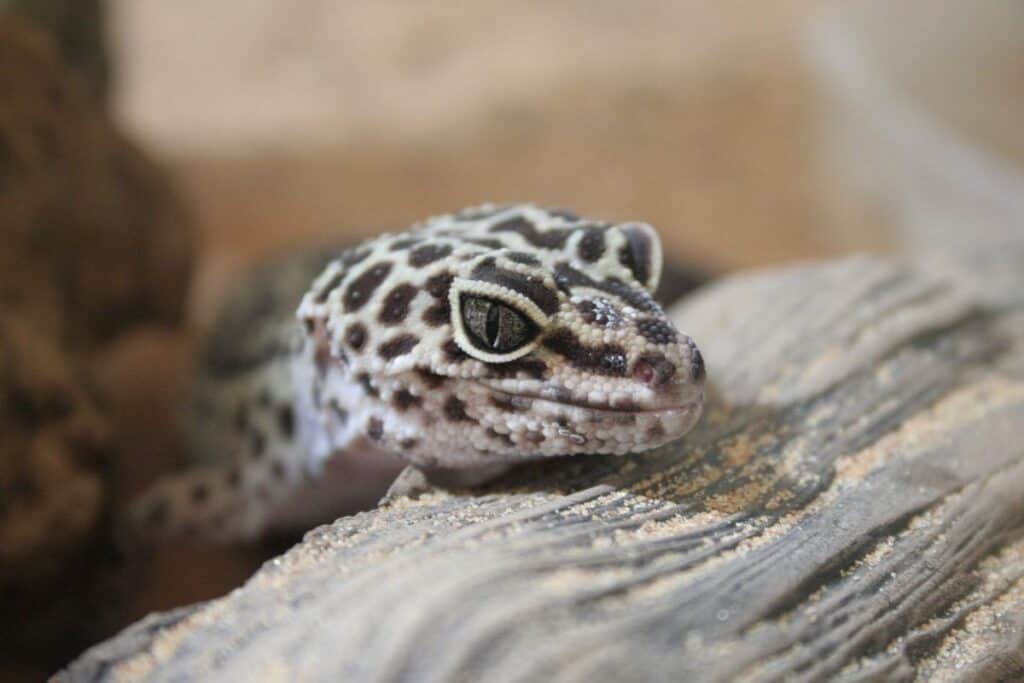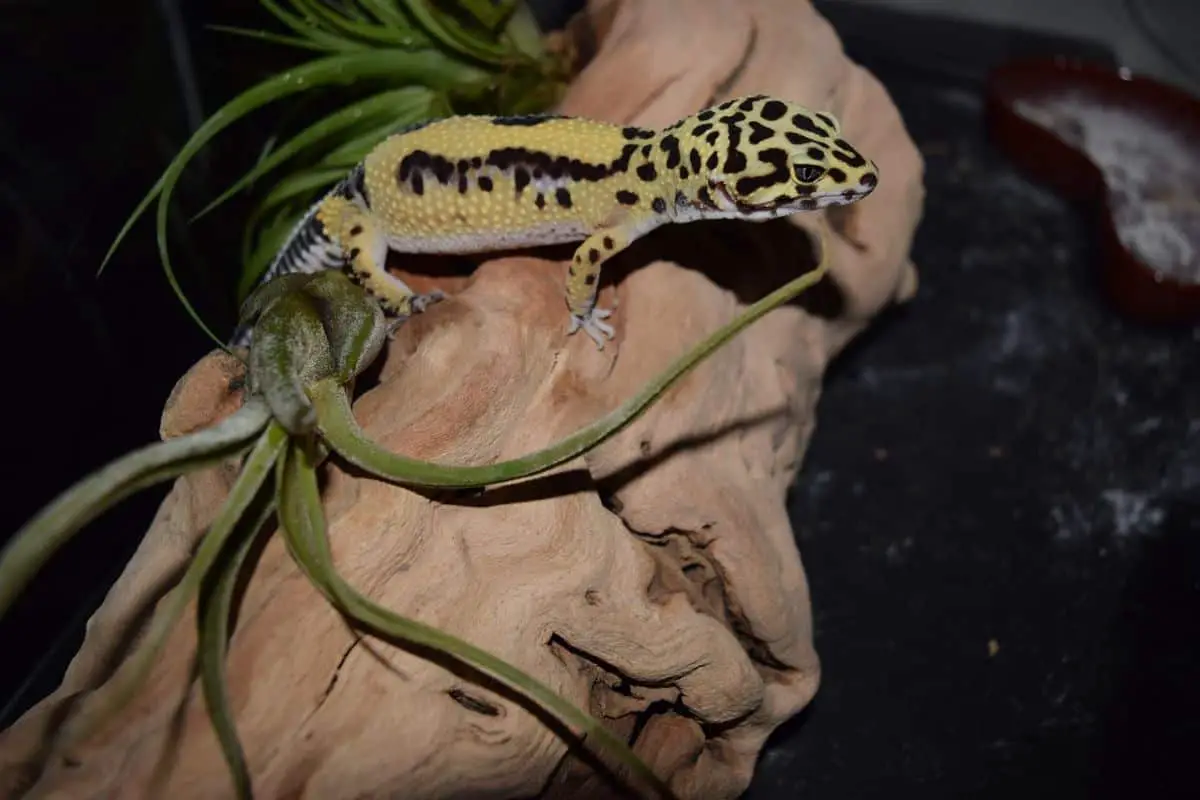Do Leopard Geckos Have Teeth? Can They Bite?
Leopard geckos are known for being docile and making great pets for beginners and even young children. However, leopard geckos can bite!
But have no fear, a bite from a leopard gecko is rarely more than a pinch and bruises nothing more than your ego!
Reptile Roommate is a participant in the Amazon Services LLC Associates Program. As an Amazon Associate I earn from qualifying purchases.
Leopard Geckos Are Docile and Make Great Pets!
Overall, leopard geckos make great pets! They’re hardy and docile reptiles that almost anyone can take care of. Aggressive or “bitey” leopard geckos are rare.
That said, any animal can bite and leopard geckos are no different. A few things set them apart however, namely; leopard geckos are usually reluctant to bite and secondly, a bite from a leopard gecko isn’t very serious at all.
These qualities, along with being readily available and a manageable, small size, make these geckos one of the top pet reptiles available!
As mentioned earlier though, leopard geckos can bite. We’ll discuss how and why they might bite, what to do if your leopard gecko does bite you and also cover some tips to try and prevent getting bit in the first place!

Why Does My Leopard Gecko Bite Me?
The vast majority of animals, especially reptiles, are never “looking to bite” anyone. (except for their prey of course!)
Most reptiles, geckos included, would much rather run away or hide than try to bite in defense. This goes doubly so when matched against a formidable (and large) opponent such as humans.
However, being a small reptile with limited ability to ‘get away,’ one of their last resorts is to “stand and fight!” …even “fighting back” only comes after several warnings and is rarely a complete surprise.
There are certain situations that the probability of getting bitten will be higher than average. These situations include when your leopard gecko feels threatened and has no means of escape or when restrained, and again, cannot escape.
There really is no other choice for the leopard gecko in such a predicament, it’s either a last ditch effort to fight back or completely give up and be eaten (at least that’s what the gecko thinks is happening anyway).
Male leopard geckos can also become territorial if they are around other males or you’ve handled another male beforehand.
Another common reason why keepers may receive a bite from their leopard gecko is when they are feeding by hand and their gecko mistakenly ‘chomps down’ on a finger instead of the intended cricket or worm snack!
Leopard geckos love food, and some become quite excited and maybe a little overzealous when it comes to mealtime!
Lastly, there are some “special” individuals that just seem to be grumpy and don’t appreciate all the love and affection that we’re so anxious to shower upon them. Individuals such as this seem to be in the minority however.
Does A Leopard Gecko Bite Hurt? Or Cause Injury?
So, even if you’re the ‘lucky’ individual that happens to adopt an ornery, grumpy, grinch of a leopard gecko that does bite every now and then; the good news is most leopard gecko bites really aren’t that big of a deal!
In fact, out of all the leopard gecko bites I’ve ever experienced, my pride (and not my fingers) always took the most damage!
Do Leopard Geckos Have Teeth?
Leopard geckos do have tiny, little teeth that they use to capture, grab and hold onto their food. They fortunately don’t do much damage to fingers or hands.
That’s not to say that on occasion, an especially large leopard gecko, can’t bite hard enough to draw a little blood; they can and it does happen from time to time. (very rare)
Most likely, this happens if the gecko bites a sensitive area like the webbing between fingers or bites “just the skin” right on the surface instead of a big ‘CHOMP’ with its mouth around the entire finger.
Even the worst (and rare) bite from an adult leopard gecko is nothing more than a surface scratch; certainly less damage than from a pet cat, bird or rodent.
What Should I Do If My Leopard Gecko Bites Me?
There are a few things that need to be done if your leopard gecko actually does bite you.
The FIRST thing to do after being bit is to recognize if the leopard gecko is “latched on” to the finger or area that was bit.
If the leopard gecko has bitten a finger, for example, and won’t let go; DO NOT SHAKE, PULL OR PRY the gecko in an attempt to get it to let go!
A leopard gecko can chomp down on a finger and your natural reaction can be to wave your hand wildly or try to ‘fling’ the offending reptile off. Try to fight this urge!
Your leopard gecko can be seriously injured if thrown across the room or dropped onto the floor because of your reaction to being bit. Unfortunately, they can even be gravely injured from such a fall!
How to Treat a Leopard Gecko Bite
Other than YOU not hurting your GECKO, the only thing that you really need to do after a bite is to wash the area with warm, soapy water.
Any reptile can carry infection or disease; it is best practice to wash the bite well to prevent any possibility of infection. The rarest of leopard gecko bites will require a small bandage. (again, this is NOT the norm)

How to Prevent My Leopard Gecko From Biting
There are a few things to look out for and some tips that you can use to put your gecko at ease and prevent unwanted bites.
5 Tips to Tame a Leopard Gecko and Stop Biting
1.) Don’t handle your leopard gecko immediately after bringing it home or moving it to a new enclosure.
Such a sudden and drastic change in your leo’s environment is sure to cause some stress and put your gecko ‘on edge.”
Waiting a day or two to let your leopard gecko settle into its new home can help prevent biting and the stress and uncertainty that comes along with such a change.
2.) Don’t move too quickly or approach your leopard gecko from above, as a predator might.
Fast movements from above can cause your gecko to become defensive. Instead approach your gecko slowly, from the side and gently slide your hand underneath its belly as you gradually lift it off the ground.
3.) Look for warning signs before attempting to hold your leopard gecko.
Geckos have personalities too and like us, they sometimes are just not ‘in the mood’ and would rather be left alone.
Signs such as, tail swaying slowly back and forth, hissing (or even “screaming”), standing their ground with an open mouth or even charging straight at you are all ways that your leopard gecko is trying to communicate that “it’s not really in the mood” for handling or your affection.
4.) Take your time! You have plenty of time to become ‘friends’ with your leopard gecko!
Your leo is going to potentially be with you for nearly 20 years! There’s no need to rush your introduction or try to hurry the taming process.
Interact with your leopard gecko for a few minutes at a time, maybe a few times a day. Try to make each and every interaction a positive one. If your leo doesn’t seem to be ‘feeling it’ that day, it’s okay; try again tomorrow.
It will take some time for your gecko to trust you and realize that it’s not in danger when it’s around you. Your patience will pay off big time and the trust that you develop will last a lifetime!
5.) A serious sign of stress and unwanted attention is caudal autonomy; your leopard gecko will ‘drop’ its tail.
This usually results from an extremely stressful situation such as being held against its will, gripped too hard or having its tail grabbed, or being constantly poked at, grabbed at, or repeatedly chased.
If your leopard gecko does drop its tail because of your repeated attempts to interact; it’s definitely time to take a break.
A gecko that drops its tail is under extreme stress and needs to be left alone in order to heal. In time, a new (not quite the same) tail will begin to regrow.
Why Does My Leopard Gecko Bite When I’m Feeding?
Sometimes an overzealous leopard gecko will chomp on a finger or two while in feeding mode. This is something a little different than biting for any other reason, and it’s easily fixed.
If your leopard gecko bites you while feeding it’s honestly not anyone’s fault and no one is really to blame. Leos aren’t the most accurate when it comes to capturing (chomping down on) food!
This type of biting is easily remedied by using tongs to feed your leopard gecko instead of your bare fingers!
Leopard Gecko Bites (Or Lack Thereof)
Yes, leopard geckos do sometimes bite. It’s a fact of keeping a reptile. However, biting doesn’t have to ruin the relationship between your leopard gecko and you!
By learning why your leopard gecko might bite, understanding the warning signs before a bite happens and by putting in the time and effort to develop trust you can have an awesome pet and a “reptile roommate” for many years to come!


